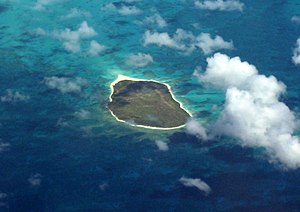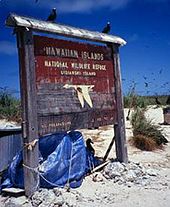Lisianski
| Lisianski | ||
|---|---|---|
| Aerial view of the Lisianski island | ||
| Waters | Pacific Ocean | |
| Archipelago | Northwest Hawaii Islands | |
| Geographical location | 26 ° 3 '50 " N , 173 ° 58' 2" W | |
|
|
||
| length | 1.9 km | |
| width | 1.1 km | |
| surface | 1.556 km² | |
| Highest elevation | 12 m | |
| Residents | uninhabited | |
Lisianski ( Hawaiian : Papa ' āpoho ) is a small, uninhabited island in the Pacific Ocean , which geographically belongs to the Northwest Hawai'i Islands and politically to the US state of Hawaii .
geography
The island is located 215 km west of the neighboring island of Laysan and is a good 1700 km from the capital Honolulu on Oahu . Lisianski represents the small and sandy, the sea surface piercing, highest elevation of the Neva Shoals , a coral reef with 979 km² comparatively large . The island itself, on the other hand, has an area of only 1.556 km² and in the north reaches a height of up to 12 m above sea level.
history
The island was discovered and named after Yuri Fjodorowitsch Lisjanski (Russian: Юрий Фёдорович Лисянский), a captain of the Imperial Russian Navy , whose ship Neva stranded in the reef east of the island during a round-the-world expedition led by Admiral Adam Johann von Krusenstern on October 15, 1805 . He set foot on the island for the first time three days later, on October 18th. In 1857 Lisianski, like most of the other islands in the chain of islands, was taken over by the Hawaiian King Kamehameha IV . Like Laysan, Lisianski was leased to the North Pacific Phosphate and Fertilizer Company for twenty years to mine guano in 1890 . In 1909 the island is a part of the bird sanctuary Hawaiian Islands Bird Reservation , in 2006, part of the Papahānaumokuākea Marine National Monuments . Lisianski may only be entered for scientific purposes today with the special permission of the US Fish & Wildlife Service .
Animal world (fauna)
Introduced mice and rabbits as well as poachers , egg and feather collectors led to a drastic decline in the bird populations residing on Lisianski at the beginning of the 20th century. In a single action in 1910, i.e. after the establishment of the bird sanctuary, 1.4 tons of feathers were confiscated and burned, which corresponds to around 140,000 birds. Widely used on the island today are the Sooty Tern ( Onychoprion fuscata ) and the Bonin shearwaters ( Pterodroma hypoleuca ) nest of all Hawaiian Low Lisianski from the nearly 75%. Migratory birds include the Pacific golden plover ( Pluvialis fulva , Hawaiian: kolea ), the sandpiper ( Tringa incana , Hawaiian: ulili ) or the curlew ( Numenius tahitiensis , Hawaiian: kioea ).
In addition, the island is a retreat for the Hawaiian monk seal ( Monachus schauinslandi , Hawaiian: Sila Hawaiʻi ) or the green turtle ( Chelonia mydas , Hawaiian: Honu ).
Web links
Individual evidence
- ↑ United States Census Bureau, Lisianski Island: Blocks 1014, Census Tract 114.98, Honolulu County, Hawaii (English)
- ↑ Jane's Oceania Page - Lisianski Island (English)
- ↑ NWHI Multi-Agency Education Project: about Lisianski Island ( Memento of the original from March 18, 2004 in the Internet Archive ) Info: The archive link was inserted automatically and has not yet been checked. Please check the original and archive link according to the instructions and then remove this notice. (English)


